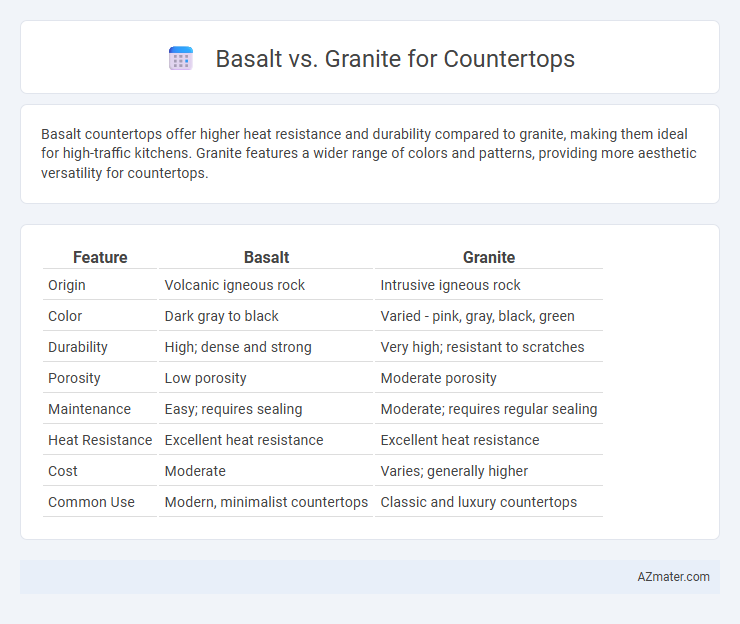Basalt countertops offer higher heat resistance and durability compared to granite, making them ideal for high-traffic kitchens. Granite features a wider range of colors and patterns, providing more aesthetic versatility for countertops.
Table of Comparison
| Feature | Basalt | Granite |
|---|---|---|
| Origin | Volcanic igneous rock | Intrusive igneous rock |
| Color | Dark gray to black | Varied - pink, gray, black, green |
| Durability | High; dense and strong | Very high; resistant to scratches |
| Porosity | Low porosity | Moderate porosity |
| Maintenance | Easy; requires sealing | Moderate; requires regular sealing |
| Heat Resistance | Excellent heat resistance | Excellent heat resistance |
| Cost | Moderate | Varies; generally higher |
| Common Use | Modern, minimalist countertops | Classic and luxury countertops |
Introduction to Basalt and Granite Countertops
Basalt countertops are crafted from volcanic igneous rock, prized for their deep black color, fine-grained texture, and exceptional durability, making them resistant to heat and scratches. Granite countertops, formed from cooled magma, feature a wide variety of colors and natural patterns, providing both aesthetic versatility and robust hardness suitable for kitchen use. Both materials offer long-lasting surfaces ideal for countertops, with basalt standing out for uniformity and granite favored for its dynamic, speckled appearance.
Geological Origins of Basalt and Granite
Basalt forms from the rapid cooling of basaltic lava at the Earth's surface, resulting in a fine-grained, dense igneous rock commonly found in volcanic regions. Granite originates from the slow crystallization of magma deep within the Earth's crust, characterized by its coarse-grained texture and interlocking mineral crystals of quartz, feldspar, and mica. The contrasting geological origins influence their durability, appearance, and suitability for countertop applications.
Physical Appearance and Color Variations
Basalt countertops showcase a consistent, deep black to dark gray color with a smooth, fine-grained texture, offering a sleek and uniform appearance ideal for modern kitchen designs. Granite displays diverse color variations, ranging from light beige and pink to dark green and blue, characterized by its granular, speckled pattern that adds unique, natural depth to countertops. The subtle elegance of basalt contrasts with granite's vibrant, fluctuating hues, allowing homeowners to choose between minimalist and visually dynamic surface aesthetics.
Durability and Strength Comparison
Basalt countertops exhibit exceptional durability due to their volcanic origin, characterized by high density and resistance to scratches, chips, and heat. Granite, formed from crystallized magma, offers comparable strength but tends to be more porous, requiring sealing to maintain its resilience against stains and cracks. Both materials provide robust surfaces for kitchen and bathroom countertops, with basalt delivering superior hardness and longevity under heavy use.
Heat and Scratch Resistance
Basalt countertops offer exceptional heat resistance due to their volcanic origin, allowing them to withstand high temperatures without damage, making them ideal for kitchen environments. Granite also provides strong heat resistance but may experience minor discoloration or surface damage under extreme or prolonged heat exposure. Both materials rank highly in scratch resistance; however, granite's interlocking crystal structure generally offers greater durability against scratching compared to the dense, fine-grained basalt.
Porosity and Stain Resistance
Basalt countertops exhibit lower porosity compared to granite, making them inherently more resistant to stains and less likely to absorb liquids. Granite, while durable, has a more porous structure that requires sealing to prevent staining from spills and oils. The reduced porosity of basalt contributes to easier maintenance and enhanced longevity in kitchen environments where stain resistance is critical.
Maintenance and Cleaning Requirements
Basalt countertops are known for their low porosity, making them highly resistant to stains and requiring minimal sealing compared to granite. Granite, while durable, needs periodic sealing to prevent staining and protect against moisture absorption. Both materials benefit from mild soap and water for cleaning, but basalt's dense structure reduces the accumulation of dirt and grime, resulting in easier maintenance over time.
Cost Analysis: Basalt vs Granite
Basalt countertops typically cost between $70 and $120 per square foot, positioning them as a more affordable option compared to granite, which ranges from $50 to $200 per square foot depending on quality and rarity. Basalt's consistent pricing stems from its uniform availability and lower processing costs, while granite's price fluctuates due to variety, color, and origin. Homeowners seeking durability and cost-efficiency often find basalt to be a competitive choice in budget-conscious countertop installations.
Environmental Impact and Sustainability
Basalt countertops offer a lower environmental impact due to their abundant natural availability and less intensive quarrying process compared to granite, which requires significant energy for extraction and processing. Basalt's dense composition increases durability, extending countertop lifespan and reducing the need for frequent replacement, contributing to sustainability. Granite mining often leads to habitat disruption and higher carbon emissions, whereas basalt's extraction typically involves minimal ecosystem disturbance, making it a more eco-friendly choice for sustainable kitchen design.
Which Is Better: Basalt or Granite for Countertops?
Basalt and granite are both durable igneous stones ideal for countertops, but granite is generally better due to its greater variety of colors, patterns, and natural resistance to scratches and heat. Basalt is denser and has a finer grain, offering a sleek, dark appearance but tends to be less abundant and more expensive. Granite's widespread availability and proven longevity make it a more practical and cost-effective choice for kitchen countertops.

Infographic: Basalt vs Granite for Countertop
 azmater.com
azmater.com